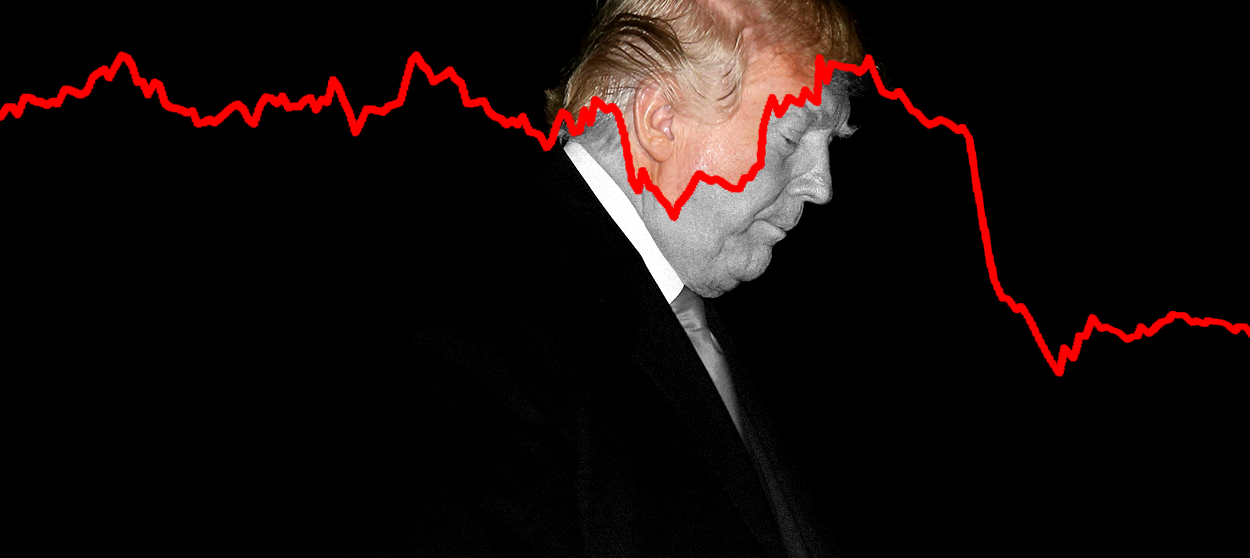The GOP just got hammered during an economic boom. What happens when it goes bust?
If a recession hits, there aren't enough caravans in the world to deliver Trump a second term


There is no denying that Tuesday was a bad election for the Trumpublicans. Although votes are still being counted, and the GOP will probably pick up a couple Senate seats, final results will likely show the biggest loss of GOP House seats since 1974. That poor showing looks even worse when you consider the incumbent party benefits from an ongoing economic boomlet. Economic growth has accelerated, wages are growing, and the unemployment rate sits at the lowest level since 1969. Consumer confidence is at its highest level in 18 years.
Yet none of that was enough to save the House from the spillover of an unpopular president. Some Republican strategist somewhere must be gaming out what to do if that boomlet goes bust, and the economic tailwind turns into a headwind. And if they aren't, they really should. The more than nine-year-old economic expansion is the second longest in U.S. history. And while expansions don't die of old age, they are often accidentally killed by the Federal Reserve.
Here's what usually happens: Late in an economic cycle, a tight labor market can overheat and lead to rising inflation. In response, the Fed begins raising interest rates — hopefully just enough to keep inflation at bay without tightening financial conditions so much that the economy slips into a recession. The goal is a cooldown or "soft landing," but the Fed is rarely successful. Usually the expansion comes crashing down, and the unemployment rate rockets higher.
The Week
Escape your echo chamber. Get the facts behind the news, plus analysis from multiple perspectives.

Sign up for The Week's Free Newsletters
From our morning news briefing to a weekly Good News Newsletter, get the best of The Week delivered directly to your inbox.
From our morning news briefing to a weekly Good News Newsletter, get the best of The Week delivered directly to your inbox.
Maybe Jerome Powell's Fed will be successful where so many others weren't. Maybe it can carefully calibrate its tightening phase and avoid a "hard landing." But President Trump is obviously worried it can't, which explains his escalating attacks on the chairman he nominated last year. "Every time we do something great, he raises the interest rates," Trump said in a Wall Street Journal interview late last month, adding that Powell "almost looks like he's happy raising interest rates."
The president seems to be suggesting that if the economy tanks, Americans should blame Power rather than the guy who picked him.
Of course, the irony here is that Trumponomics is one reason the Fed is raising rates as quickly as it is. The economy was already pretty boomy when Trump signed the Tax Cuts and Jobs Act last December. The unemployment rate had steadily declined to 4.1 percent from 10 percent in 2009. Few economists on the left or right were arguing for a budget-busting tax cut. Indeed, many warned that massive fiscal stimulus in an economy at or near full employment would force the Fed to lean harder against it. And that's just what seems to be happening. But the more severe the Fed action, the greater the chances of a monetary mistake.
Wall Street banks are reluctant to predict recessions, but many are predicting an economic slowdown by the 2020 election. And it's not just because of the Fed. The baseline growth potential of the American economy is probably a lot lower than what we've seen lately with 4.2 percent growth in the second quarter and 3.5 percent in the third. But this isn't a 4 percent economy or a 3 percent economy. It might not even be a sustainable 2 percent economy. The higher rates of growth we've seen lately have come from bringing workers off the sidelines. But as JPMorgan economist Michael Feroli notes in a new report, "With participation rates for many demographic groups now returning to pre-[financial] crisis levels, it will be harder to squeeze further gains from above-trend labor supply growth."
A free daily email with the biggest news stories of the day – and the best features from TheWeek.com
So unless the U.S. is going to start importing lots of new workers, much faster economic growth will require much greater worker productivity. And there's little sign of that happening. The tax cut was supposed to boost business investment and then productivity growth — not just temporary consumer demand — but there is nothing in the data to suggest this thesis is panning out. "No amount of wishing it away will change the fact that we remain mired in a slow growth regime," Feroli concludes.
Even without a true recession, the 2020 Trump economy might resemble the 2016 Obama economy that Hillary Clinton ran on and Trump slammed as a disaster. Real GDP growth that year was 2.2 percent. The median Fed forecast for 2020 is 2.0 percent growth, with some investment firms expecting something closer to 1.5 percent. It was that sort of meh economic growth that led the well-known forecasting model developed by Yale's Ray Fair to predict Clinton would get just 44 percent of the two-party vote. (The actual number was 51 percent.) In other words, Clinton outperformed what would have been expected given so-so economic conditions, an error that Fair speculated resulted from "Trump's personality."
Exit polls on Election Day 2016 put Trump's favorability at just 38 percent, five percentage points worse than Clinton. The same polls on Tuesday put Trump's favorability at 45 percent, boosted perhaps by recent strong jobs and GDP reports. What might they be on Election Day 2020 with an economy fading rather than accelerating and Trump as Trumpy as ever? There might not be enough refugee caravans in the world to give the president a second term.
James Pethokoukis is the DeWitt Wallace Fellow at the American Enterprise Institute where he runs the AEIdeas blog. He has also written for The New York Times, National Review, Commentary, The Weekly Standard, and other places.
-
 The ultimate films of 2025 by genre
The ultimate films of 2025 by genreThe Week Recommends From comedies to thrillers, documentaries to animations, 2025 featured some unforgettable film moments
-
 Political cartoons for January 3
Political cartoons for January 3Cartoons Saturday's political cartoons include citizen journalists, self-reflective AI, and Donald Trump's transparency
-
 Into the Woods: a ‘hypnotic’ production
Into the Woods: a ‘hypnotic’ productionThe Week Recommends Jordan Fein’s revival of the much-loved Stephen Sondheim musical is ‘sharp, propulsive and often very funny’
-
 Bari Weiss’ ‘60 Minutes’ scandal is about more than one report
Bari Weiss’ ‘60 Minutes’ scandal is about more than one reportIN THE SPOTLIGHT By blocking an approved segment on a controversial prison holding US deportees in El Salvador, the editor-in-chief of CBS News has become the main story
-
 Has Zohran Mamdani shown the Democrats how to win again?
Has Zohran Mamdani shown the Democrats how to win again?Today’s Big Question New York City mayoral election touted as victory for left-wing populists but moderate centrist wins elsewhere present more complex path for Democratic Party
-
 Millions turn out for anti-Trump ‘No Kings’ rallies
Millions turn out for anti-Trump ‘No Kings’ ralliesSpeed Read An estimated 7 million people participated, 2 million more than at the first ‘No Kings’ protest in June
-
 Ghislaine Maxwell: angling for a Trump pardon
Ghislaine Maxwell: angling for a Trump pardonTalking Point Convicted sex trafficker's testimony could shed new light on president's links to Jeffrey Epstein
-
 The last words and final moments of 40 presidents
The last words and final moments of 40 presidentsThe Explainer Some are eloquent quotes worthy of the holders of the highest office in the nation, and others... aren't
-
 The JFK files: the truth at last?
The JFK files: the truth at last?In The Spotlight More than 64,000 previously classified documents relating the 1963 assassination of John F. Kennedy have been released by the Trump administration
-
 'Seriously, not literally': how should the world take Donald Trump?
'Seriously, not literally': how should the world take Donald Trump?Today's big question White House rhetoric and reality look likely to become increasingly blurred
-
 Will Trump's 'madman' strategy pay off?
Will Trump's 'madman' strategy pay off?Today's Big Question Incoming US president likes to seem unpredictable but, this time round, world leaders could be wise to his playbook
